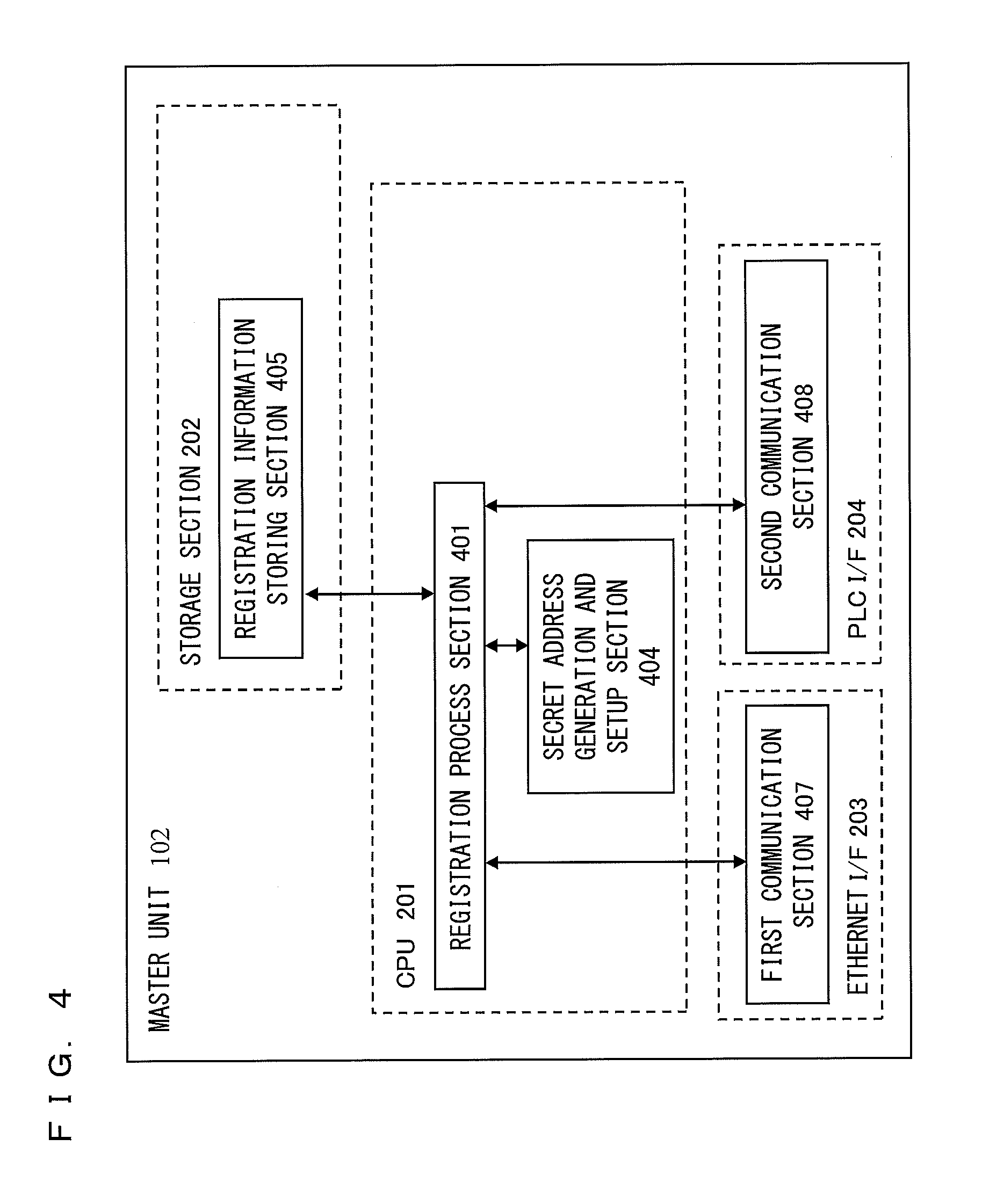Master unit and slave unit
a slave unit and master technology, applied in the field of master units and slave units, can solve the problems of inability to change the authentication key that the slave unit retains from the one set at the time of manufacture of the slave unit, inability to secure security, and inability to ensure security
- Summary
- Abstract
- Description
- Claims
- Application Information
AI Technical Summary
Benefits of technology
Problems solved by technology
Method used
Image
Examples
first embodiment
[0062]In a first embodiment, a registration process performed between a master unit 102 and each of slave units 103a to 103n will be described. FIG. 4 is a function block diagram showing functions of the master unit 102 in comparison with the physical configuration of the master unit 102 in FIG. 2. In FIG. 4, a CPU 201 has functions of a registration process section 401 and a secret address generation and setup section 404. A storage section 202 has a function of a registration information storing section 405. An Ethernet I / F 203 has a function of a first communication section 407. A PLC I / F 204 has a function of a second communication section 408. The registration information storing section 405 stores a unique address and a unique key of a slave unit 103 (that is, registration information of the slave unit 103) which has been registered.
[0063]The registration process section 401 performs a process in response to a command inputted via the first communication section 407, and, base...
second embodiment
[0123]In a second embodiment, procedures of an initial registration process and a re-registration process performed between a master unit 102 and each of slave units 103a to 103n are different from those in the first embodiment. Function block diagrams of the master unit 102 and the slave unit 103 are the same as those in the first embodiment, and thus descriptions will be made with reference to FIG. 4 and FIG. 5. In the following, only operations different from those in the first embodiment will be described.
[0124]FIG. 21 is a flow chart showing an initial registration process performed by a master unit 102 according to the second embodiment. In FIG. 21, the master unit 102 omits operations of step S1003, S1004, and S1014 which are performed in the initial registration process (see FIG. 10) according to the first embodiment. FIG. 22 is a flow chart showing an initial registration process performed by a slave unit 103 according to the second embodiment. In FIG. 22, the slave unit 10...
third embodiment
[0152]In a third embodiment, description will be made of an authentication process performed so that a communication key is shared between a master unit and a slave unit which already share a unique key. Upon termination of the initial registration process, each of slave units 103a to 103n can specify a unique address of a master unit 102 as a destination address, request the master unit 102 for the authentication process, and receives a communication key from the master unit 102. In the following, in addition to the initial registration process and a re-registration process, configurations of the master unit 102 and the slave unit 103 which perform the authentication process will be described. FIG. 27 is a function block diagram of a master unit 102 according to the third embodiment. In FIG. 27, a CPU 201 has, in addition to functions of a registration process section 401 and a secret address generation and setup section 404, a function of a communication authentication section 402...
PUM
 Login to View More
Login to View More Abstract
Description
Claims
Application Information
 Login to View More
Login to View More - R&D
- Intellectual Property
- Life Sciences
- Materials
- Tech Scout
- Unparalleled Data Quality
- Higher Quality Content
- 60% Fewer Hallucinations
Browse by: Latest US Patents, China's latest patents, Technical Efficacy Thesaurus, Application Domain, Technology Topic, Popular Technical Reports.
© 2025 PatSnap. All rights reserved.Legal|Privacy policy|Modern Slavery Act Transparency Statement|Sitemap|About US| Contact US: help@patsnap.com



